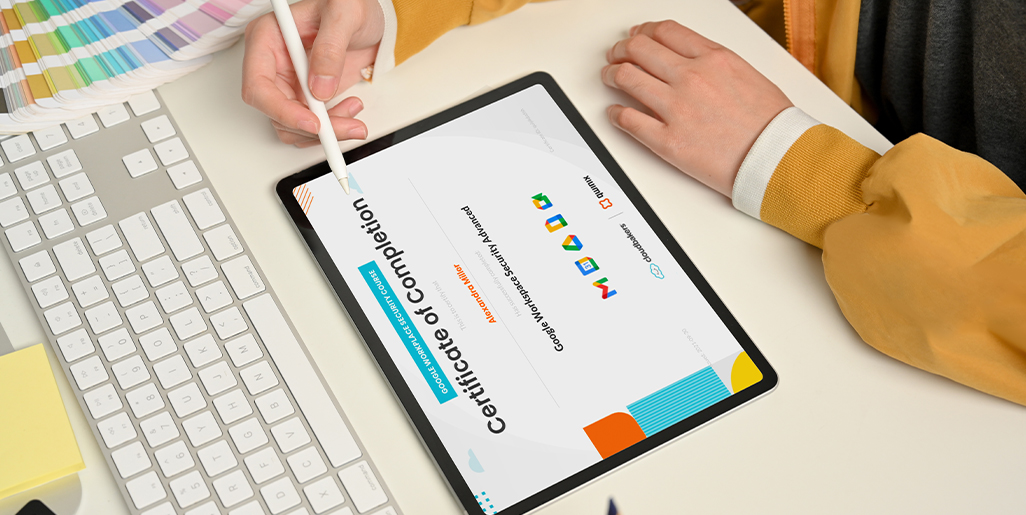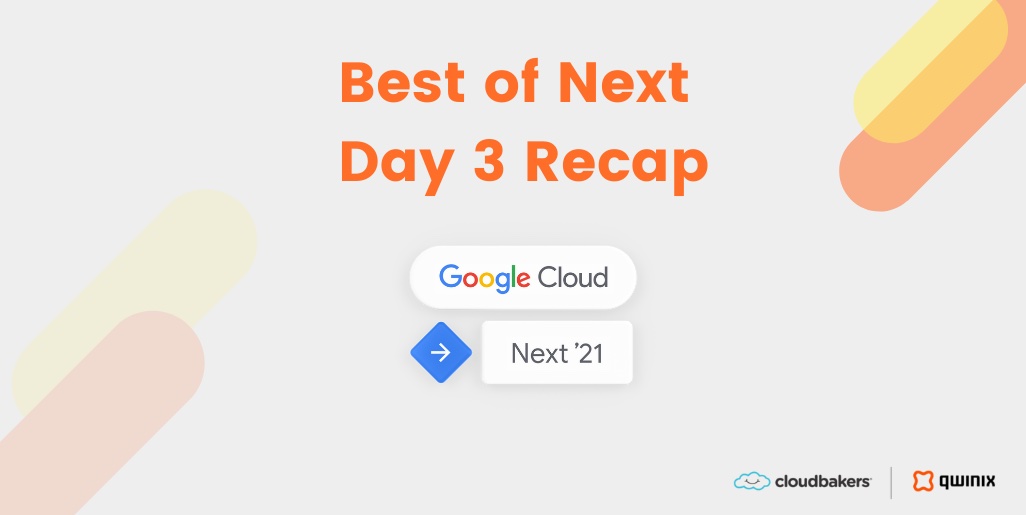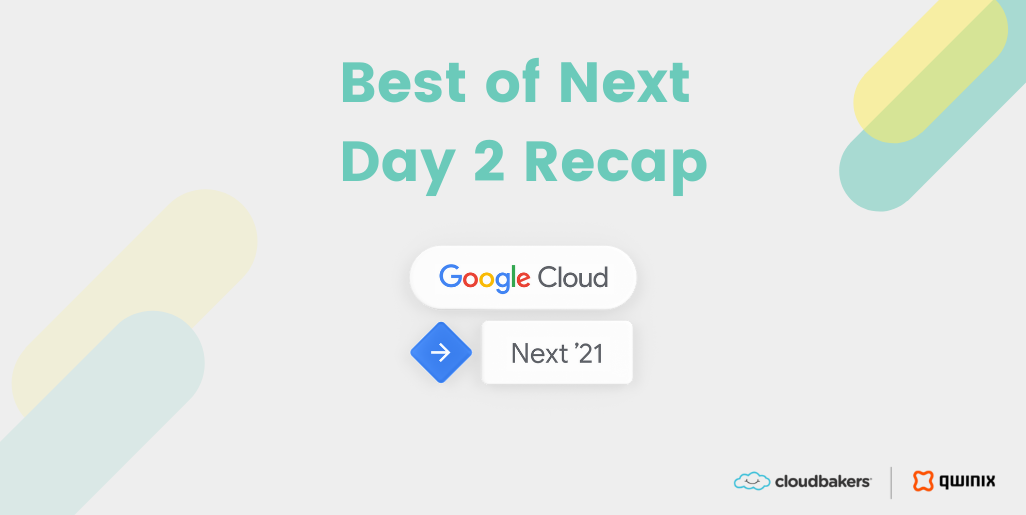Google Cloud Next ‘21 came back for its fifth year, officially kicking off on Oct. 12th. All three days of Next featured a variety of in-depth discussions, Q&As, hands-on learning opportunities, live community meet-ups and more, all looking towards “solving what’s next.”
Throughout Google Cloud Next ‘21, there was a strong focus on community and increasing innovation through inclusive workspaces and platforms. There were several data cloud launches, including Vertex AI Workbench, Earth Engine for Google Cloud, and Spark for Google Cloud to name a few. Security and zero-trust announcements were another top highlight this year, as well as ways to make multi-cloud more accessible.
All-in-all, these were the top updates, announcements, and takeaways from all three days of Google Cloud Next ‘21.
Vertex AI Workbench
Aiming to help engineers work more efficiently, without having to jump from service to service, Vertex AI is now available in preview.
Vertex AI Workbench is a managed notebook solution that acts as the “single development environment for the entire data science workflow.” Technologists can now build and train models up to five times faster and can quickly access machine learning with tools like BigQuery and Spark within the same environment.
Google Cloud has provided in-depth documentation on Vertex AI Workbench, including an Vertex AI tutorial.
BigQuery Omni
During Google Cloud Next ‘21, it was announced that BigQuery Omni is now generally available. Technologists can now use the BigQuery framework to seamlessly manage data from AWS or Azure without moving it into Google Cloud.
This is part of the Google Cloud priority to provide users with more multi-cloud solutions, making workflows easier and faster to manage.
David “Mac” McDonald, a Google Cloud Certified Fellow in Hybrid, Multi-Cloud and the VP of Cloud Services at Cloudbakers | Qwinix reiterated that, “The announcements also foreshadowed features coming early next year that allow for integration of that data with data in other clouds or clouds that already exist in BigQuery, adding even more value to BigQuery Omni.”
Explore how BigQuery Omni can help bring your data together.
Looker + Tableau Integration
One of the biggest announcements from Google Cloud Next ‘21 was that Tableau now integrates with Google Cloud’s Looker. This integration includes full access to Looker’s semantic model and support for LookML and Google Sheets.
For our customers, Looker solves governance problems around business metrics. Google Cloud is seeing the strategic problem this solves for customers. This Looker integration helps customers clearly separate analytics engineering and metrics definition processes from visualization and reporting processes.
Jesse Kinsella, a Looker Developers at Cloudbakers | Qwinix, summarized the importance of this integration. “Tableau and Looker are great compliments of one another. Tableau provides a rich set of tools for creating beautiful data visualizations, while Looker’s data modeling layer provides a powerful method for centralizing data for governance.”
Explore the integration further: Google’s Looker and Tableau.
Anthos for VMs
Today, many companies are still using a combination of containers and VMs, which means they have to use separate processes and workspaces for each. With Google Cloud’s announcement of Anthos for VMs, this is no longer the case.
As Google Cloud’s modern application development platform, Anthos provides hybrid and multi-cloud application management. Anthos for Virtual Machines will allow you to standardize on Kubernetes while continuing to run some workloads that cannot be easily containerized in virtual machines.
Anthos Multi-Cloud API was also announced. This solution allows developers to create and manage clusters right from the web console for both AWS and Azure cloud environments. These Anthos clusters also integrate with public cloud providers’ specific resources, such as load balancers and persistent storage, to simplify the experience.
Learn more about how Anthos makes hybrid cloud management possible.
Community Development for Cloud Innovators
Day three of Google Cloud Next ‘21 featured a spotlight talk between Vint Cerf, VP and Chief Internet Evangelist at Google Cloud, and Jim Hogan, Principal Innovative Strategist at Google Cloud, on inclusion and neurodiversity in the workplace.
During their discussion, Jim talked about his experience with finding inclusion in the workspace and the belief that providing better access to an inclusive work environment and building products with differently-abled and neurodivergent users in mind is essential to better innovation.
If you missed it, you can still watch their conversation here.
Google Cloud Innovators Program
The Google Cloud Innovators Program is a new, collaborative community for technologists to help them accelerate their learning and growth on Google Cloud.
Joining this free program provides developers with access to roadmap previews, the ability to connect with like-minded technologists, and an opportunity to earn industry recognition for their contributions to the larger Google Cloud community. The Innovators Program will also showcase regular conversations and Ask Me Anything sessions with Google Cloud Executives and Developer Advocates.
“The Cloud Innovators program is a great way for Google Cloud thought leaders to come together and share experiences, accelerate learning and growth, and be able to contribute to the larger community,” said David “Mac” McDaniel, VP of Cloud Services at Cloudbakers | Qwinix. “As an extension of the Google Developer community, it makes sense to amplify those that are truly innovating in Google Cloud for the benefit of all. The Champion Innovators are those that share their knowledge and experience broadly with each Champion having specialization in one or more areas.”
Mac is also a Google Cloud Certified Fellow and a Champion Innovator in the program.
To join the Google Cloud Innovators Program you must have a Google Developer Profile (you can create one for free to get started).
Spark on Google Cloud
The announcement of Spark on Google Cloud as a fully managed service highlights Google Cloud’s prioritization of the developer experience. It aims to allow technologists the ability to make their workspaces fluid and seamless.
Spark on Google Cloud is an autoscaling, serverless implementation of Apache Spark. Data engineers and data scientists can now use Spark with BigQuery, Vertex AI, Dataplex, and other Google Cloud data solutions, without worrying about cluster management or integration with their favorite data services.
Google Cloud Security Innovations
Google is all about zero trust security, and has already committed to investing $10 billion over the next five years in cybersecurity. New announcements during this year’s Google Cloud Next show how that priority is being integrated into more systems that are used daily.
One example is the Automatic Data Loss Prevention now in BigQuery. This prevents data leaks, company-wide by providing validation prior to access to systems and data. This added security also applies to supply chains, ensuring that you know at all times exactly what software is being deployed and shipped.
“Now that the U.S. Department of Defense has mandated a move to a zero trust approach, we expect to see much larger adoption in the commercial space as well,” said Scott McDonald, Qwinix | Cloudbakers Security Director and Practice Lead. “Eighty percent of organizations are planning to implement zero trust security in less than a year. Google’s new BeyondCorp Enterprise offering makes zero trust a reality today, and should be the first option on everyone’s list.”
Learn more about Google Cloud security innovations.
Google Work Safer
Google’s priority of focusing on cybersecurity includes their new Work Safer program. Work Safer provides a safer way for organizations using Google Workspace (formerly GSuite) to work together and communicate in hybrid work environments.
Work Safer combines the cloud-native, zero-trust solutions of Google Workspace with BeyondCorp Enterprise for secure access with integrated threat and data protection. Enhanced security extends to both internal users and third-party organizations, such as vendors and partners.
“I was particularly excited to see the announcement at Next about GWS integrations with Crowdstrike Falcon as well, because our company currently uses it,” said Scott McDonald. “Integrating the CrowdStrike Falcon platform and all it provides for security visibility with Google Workspace’s architecture is a natural fit when implementing Zero Trust. I’m glad that Google is leading in this space as one of the CrowdStrike Zero Trust ecosystem partners.”
Learn more about Google Work Safer.
Google Distributed Cloud
Google Distributed Cloud reinforces the importance of “the Edge” and 5G for Google Cloud customers, making this announcement a very important one. Customers have the ability to run workloads at the location that optimizes their performance and total cost.
Distributed Cloud is a set of fully managed, Anthos-enabled hardware and software solutions that bring Google Cloud’s infrastructure and services to customer locations (e.g., retail stores and factory floors) and into customer data centers.
Explore Google Distributed Cloud
PostgreSQL Interface for Cloud Spanner
In line with announcements like BigQuery Omni’s general availability and Spark on Google Cloud, the new PostgreSQL interface for the Cloud Spanner platform provides yet another multi-cloud solution for users.
The PostgreSQL interface is currently in preview. This allows developers to use their PostgreSQL skills directly within Cloud Spanner for the first time.
Learn more about PostgreSQL for Cloud Spanner.
Google Cloud Workspace Safety and Security Integrations
Along with Work Safer, a few other Google Workspace integrations were announced. These include client-side encryption for Google Meet, Google Drive labels, Data Loss Prevention (DPL) for Google Chat, and additional safeguards against abusive behavior and content.
Client-side encryption is an extension of the same ability that was announced for Sheets, Slides, Drive, and Docs last year. The new Google Drive labels allows organizations to file and manage information based on their level of sensitivity. DPL for Chat gives organizations further security to protect sensitive information. The additional safety and privacy safeguards against abusive behavior and content is currently available in Docs and will soon be available in Sheets and Slides as well.
Explore the new Google Workspace integrations.
Google Carbon Footprint Calculator
Google Cloud environments are already carbon neutral, but this new addition gives companies on Google Cloud the tooling to take their sustainability to the next level by optimizing usage.
With deep carbon reporting and estimates attached to projects, customers can look for opportunities to reduce carbon emissions, like reducing the number of idling resources. Users also now have the ability to calculate their own carbon footprint.
That’s a wrap! We hope you enjoyed this year’s Google Cloud Next. Join us again next year, and in the meantime, be sure to follow Qwinix | Cloudbakers on social for ongoing updates and announcements throughout the year.



